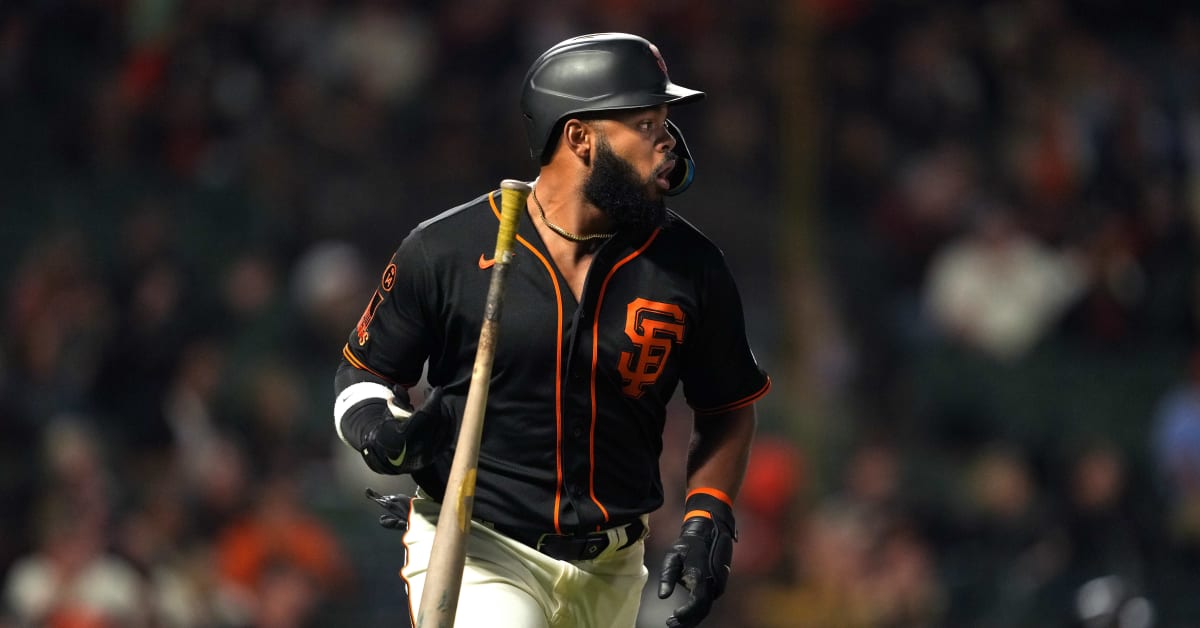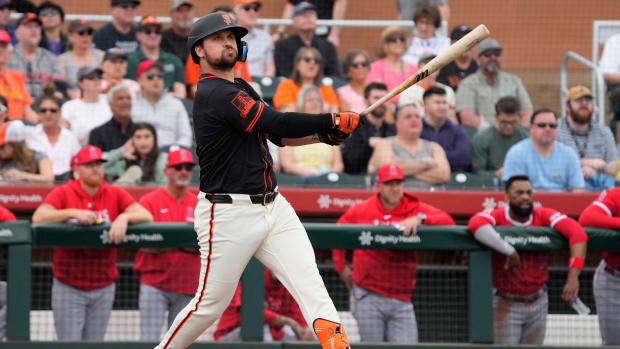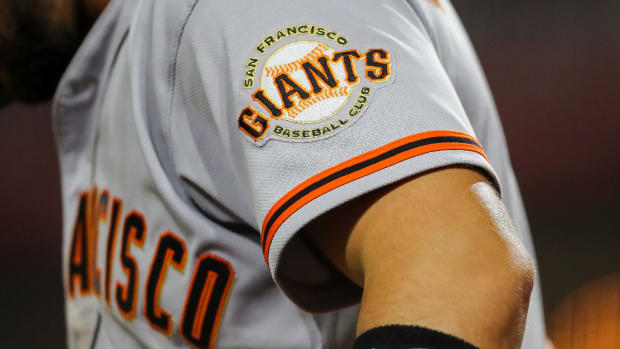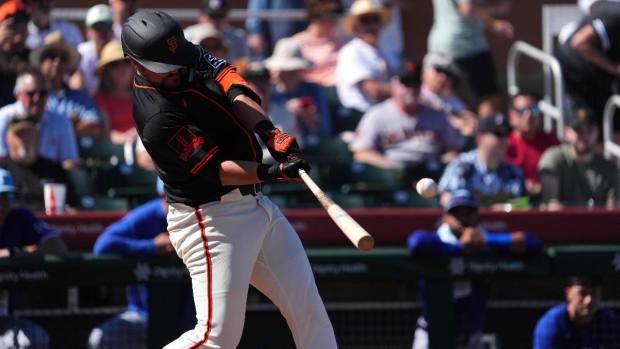
SF Giants prospects: 2023 Sacramento River Cats season in review
For the third consecutive season, the Sacramento River Cats finished below .500 and is one of the worst teams in the Pacific Coast League since the minor league realignment back in 2021. The River Cats team was more utilized as an extension of the SF Giants' 40-man roster rather than a team trying to compete for wins.
There were two dominant topics that surrounded the team all season long. The first was the general struggles of the pitching staff with the adjusted ABS system this season. The pitchers particularly struggled to throw for strikes with a smaller zone as they led the entire PCL in walks, and plenty of their pitchers posted career-worst walk rates. However, the stuff that the pitchers had was still more than enough for the team to finish with the third-most strikeouts in the league.
The second was the front office seemingly treating Sacramento as only a pit stop for their hitting prospects rather than a place for development. Position player prospects like Casey Schmitt, Patrick Bailey, Luis Matos, and Wade Meckler only stayed with Sacramento for a limited time before they were called up while Heliot Ramos and Brett Wisely bounced around as the Giants looked for offensive help from the youngins.
SF Giants 2023 DSL season in review
SF Giants 2023 ACL season in review
SF Giants 2023 Single-A season in review
SF Giants 2023 High-A season in review
SF Giants 2023 Double-A season in review
Latest SF Giants prospect rankings
Sacramento's most outstanding hitter: Tyler Fitzgerald
There was never a doubt on who to vote for as the most outstanding hitter on the River Cats roster this season. Tyler Fitzgerald earned a quick trip to Sacramento after winning the Eastern League Player of the Month. Despite starting the season at Double-A, he still led Sacramento with 102 games.
Based on the sheer volume alone, Fitzgerald easily led the River Cats in several hitting categories such as hits, doubles, triples, home runs, RBIs, and stolen bases. He also joined the 20-20 club as a River Cat, finishing the season with 20 home runs and 29 stolen bases. If we add the totals from Double-A and the Majors, he hit 24 homers and stole 34 bases. However, there was a reason why Fitzgerald got stuck in Triple-A purgatory, even though the big league club was suffering badly from the offensive ineptitude at shortstop. His wRC+ is only a tick above-average at 103, which considering the offensive environment of the PCL, was a bit underwhelming.
Other notable hitters
As mentioned earlier, many future Giants rookie hitters only used Sacramento as a quick pitstop for their eventual big league stints. Out of all of the prospects, it was Luis Matos who made the most of the opportunity. Matos' one-month stretch from the middle of May to the middle of June was one for the ages as Matos-mania fully descended. Matos had an eye-popping .398 batting average with six doubles, two triples, and seven home runs while only striking out at a very nice 6.9% rate.
The other shocking call was Patrick Bailey. The defensive potential was there at Triple-A, as his game-calling and pitch framing looked strong, but the bat looked far from being ready, with only a .216 batting average and only decent exit velocities. However, he looked strong in five out of the last six games that he played in Sacramento with two home runs before getting the call-up to San Francisco and like they say, the rest was history.
Marco Luciano also did not exactly look like a prospect who looked ready to take the next step based on his Sacramento performance with only a .209 batting average and a 36% strikeout rate. However, there were some positive signs, like his walk rate. When Luciano connected, though, it was hard contact with exit velocities north of 110 mph at best. More importantly, he's shown better defense at shortstop that he eventually carried over to The Show.
Casey Schmitt's numbers looked pretty good on the surface with a .300 average, 13 doubles, and a 20.3% strikeout rate. However, there were signs that things were not as they seemed. He's struggled to hit the ball over the fence with only four homers though the exit velocities that he posted were average. The most concerning thing is the over-aggression that is the antithesis of what the Giants want from their hitters with only a 6.5% walk rate at the PCL. Given that Schmitt looked much better when he was attacking pitchers early in the count, it's unsure whether taking more pitches put him off his rhythm.
When Wade Meckler made the jump to Triple-A, the first thing that came to my head was that there was absolutely nothing that would stop the man from hitting until he hit the majors. That's what exactly happened as he hit .354 with a .965 OPS, a 17.6% walk rate, a 19.6% walk rate, four doubles, a triple, and a couple of homers. He truly was special in 2023.
Heliot Ramos has had a roller coaster of the past couple of years and 2023 is no exception. He was getting bounced around again between Triple-A and the Majors. He still had a career year at the Triple-A and posted the best numbers since he was at San Jose in 2019 with a .300 average, .928 OPS, 14 doubles, three triples, 12 homers, a 10.3% walk rate, and a 25.1% strikeout rate.
Earlier in the season, Brett Wisely had his shot at the big league team. In fact, he was the Opening Day center fielder, which was puzzling then and still puzzling now. He was bounced around a couple of times between Sacramento and San Francisco but spent the final two months of the season. He's had a solid season with a .285 average, .883 OPS, 20 doubles, a triple, and six homers. However, his ability to control the zone is where he will earn his money, and he showed a great ability at Sacramento with a career-high 16.8% walk rate.
One of the more interesting prospects who did not receive the big-league call was Armando Alvarez. He had a sneaky good year in Sacramento as an older prospect. Among all River Cats hitters with a minimum of 200 at-bats, Alvarez led the team in slugging percentage and OPS, and was second in home runs and doubles. Not too shabby for a prospect that signed by the Giants as a minor league free agent last winter.
Ricardo Genoves served as the primary backup catcher for the River Cats who saw players like Patrick Bailey and Joey Bart play a lion's share of the time that they were there. He struggled offensively with a .218 average and a .660 OPS, but he was never known for his offensive prowess. Defensively, he's looked good with a 39% caught-stealing rate and just five passed balls this season.
Sacramento's most outstanding pitcher: Nick Avila
There were some pitchers who went undefeated in the minors this season, but nobody earned as many wins without receiving a single loss as Nick Avila, who went 14-0.
Nobody on the team was as reliable as Avila, who appeared in a team-leading 56 games. He was also highly reliable, with a 3.00 ERA. There was a reason the White Sox let go of Avila before the regular season started. He lacks elite stuff and only managed a 21.3% strikeout rate. However, the Giants deployed Avila all over, appearing across all nine innings throughout the season, and posted a respectable 12% walk rate. Whether he starts or enters the final inning with a small lead, Avila's been effective. He was also a perfect 3-3 in save opportunities.
Earning a perfect save and win-loss record was surely not on his mind when he got returned to the Giants after the White Sox selected him in the Rule 5 draft last year. However, that was exactly what happened and that is why Avila earned my vote as Sacramento's most outstanding pitcher.
Other notable pitchers
It seemed like every single Kyle Harrison start was must-see TV due to the proclamation by Farhan Zaidi early this season that he will be a factor for the Giants later this season. However, things did not exactly go as planned as he was the poster child for the ABS struggles that the River Cats pitchers had all season long. He still had the great stuff as proven by his 35.6% strikeout rate and his overall movement data but struggled to throw strikes with the tight zone with a 16.3% walk rate and only a 59% strike rate.
If there was another contender for the most outstanding pitcher, it would be Erik Miller. He was highly effective when his number was called upon with him pitching in 48 games, second best to Avila's 56. Also, among pitchers with at least 50 innings thrown, Miller's 2.77 was the best while also collecting 14 saves. Sure, he was a big victim to the ABS with an 18.5% walk rate, but he's shown that he has some of the best pure stuff from the left side in the organization with a 33% strikeout rate.
Ever since the start of the season, Sacramento pitchers struggled to throw strikes. However, there was one exception: Ryan Walker. Walker was clearly the best pitcher the River Cats had in the early season, as his sidewinding crossfire delivery wreaked havoc on the PCL. Prior to his MLB call-up, Walker had a 0.89 ERA, 31.1% strikeout rate, a .138 opponent batting average, a 0.84 WHIP, and a 10.8% walk rate.
A couple of big-league rookie pitchers also called Sacramento their home throughout stretches of the season as the front office kept on bouncing them around. Keaton Winn continued to be one of the better strike throwers in the system as he did not look bothered with the ABS as the season wore on with a solid 10% walk rate alongside a 26% strikeout rate. Tristan Beck definitely looked better in the big leagues compared to Winn, as Beck's trio of pitches with glove-side movement was above-average in terms of pure stuff. When Beck was in Triple-A, though, he seemed to struggle with a 5.88 ERA and only a 23% strikeout rate.
Kai-Wei Teng curiously earned an early promotion to Triple-A after dominating Double-A/ There were some hiccups along the way, including how he ended his season by allowing 10 earned runs over his final two starts, but there was a stretch in July where he was on a roll, including five straight starts where he only allowed just three earned runs. He's proven that the stuff can play at the level with a 27.6% strikeout rate.
Mason Black earned his mid-season call-up right after Teng earned his. As expected, Black had a slight dip in his performance, with only a 28% strikeout rate, a 12% walk rate, and a 3.86 ERA. However, there were signs that Black might be suffering from the extreme hitting environment as there were signs that he could have been a better pitcher with a 16.7% HR/FB rate and a .314 BABIP.
In terms of sheer nastiness, Chris Wright was as nasty as they come out of the Sacramento bullpen this year, as his 28.4% strikeout rate was in line with what he's shown earlier in his career. The carry that he generated with his fastball helped him generate above-average whiffs even though his fastball velocity sat a tick below average. However, the bigger issue is his walk rate, as his 20.5% rate is one of the worst in the league.
Speaking of stuff, Randy Rodriguez never really lacked stuff. The biggest problem for him has always been corraling that stuff. He once again struggled to throw strikes when he encountered the ABS being implemented at the Triple-A level with a 20.7% walk rate. However, his strikeout rate also experienced a wild dip, like when he pitched at the level last year with just a 23% strikeout rate. Triple-A hitters have always shown patience whenever Rodriguez is on the mound.
Kade McClure was traded to the Giants when the White Sox acquired Gregory Santos. It was not one of the finest trades of the Zaidi regime as Santos blossomed into one of Chicago's best relievers while McClure struggled mightily with a 5.79 ERA and only 13 strikeouts in 23.1 innings pitched.





